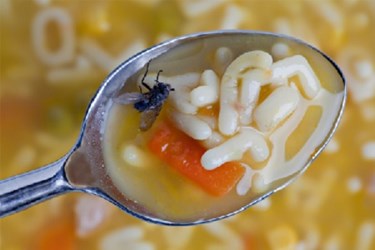8 Tips To Prevent Food Contamination
By Melissa Lind, contributing writer

Rejects can slow down a food-processing line, costing valuable time and loss of product. Worse yet, a recall can have much greater costs in dollars, brand reputation, and loss of consumer confidence. The following 8 guidelines can help prevent foreign-body contaminants from entering your company’s products.
Metal Contaminants
Preventative maintenance can keep some potential contaminants from ever reaching food-processing lines. Routine maintenance can reduce the chance that loose screws, bolts, or other pieces of equipment will enter production. The effective use of X-Ray inspection, magnetic- or metal-detection technology can identify nearly all metal fragments.
Plastics
The first line of defense in preventing plastic contaminants may be the use of sieves or screens to filter out plastic from food products. In-line use of X-Ray inspection can also identify higher- density plastic contaminants at a very small size, though they do not work well with lower-density plastic.
Glass
This is one of the most-difficult contaminants detect. Glass should not be kept in a food-producing facility unless absolutely necessary. When needed, X-Ray detection is often successful with identifying glass as the technology is capable of finding different densities within a food product.
Bone Fragments
Bone is a common contaminant of meat products. Many facilities reduce the chance of bone contamination by using deboned meat as a raw ingredient or may use specialized bone removal systems in grinding operations. X-Ray inspection and other technologies may also identify cases where bones have become a contaminant in a food product.
Wood And Stone Foreign Bodies
Natural contaminants, such as wood chips and rocks, are non-toxic, but may present other hazards. Good hygiene practices and screening devices may prevent a good deal of contamination. X-Ray detection systems will frequently identify stones, but do not function as well with wood. How this depends on density in comparison to product.
Insects
Insects or insect body parts are best prevented by good hygiene. Regular inspection and treatment with a professional pest-control company will reduce the chance that insect contamination will occur and is especially important as most product-inspection systems will not detect insect bodies or parts.
Jewelry
This is an unexpected contaminant. Employees may be negligent and allow jewelry to fall into the food-processing line, resulting in a large number of incidences. To prevent jewelry contamination, policies should be established to prevent employees from wearing jewelry while at work.
Other Possible Foreign-Body Contaminants
An amazing array of “other” contaminants can range from bandages and hair ties to pens and keys. There is no single system to detect every type of potential contaminant and most of these are easily prevented. Employees should have pocket-less clothing and strict policies should exist to prevent other contaminants.
The best way to stop contaminants from reaching final products is to prevent them from ever entering the food-processing lines by obeying strict, established protocols.
